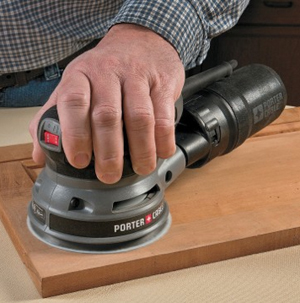
We have a toy box lid that has warped after it has been sanded. We are using kiln-dried pine (6 to 8 percent), flat/plainsawn, that is 3/4-in.-thick, 21 inches wide by 32 inches long. The individual boards are 4 inches wide or less and we have alternated the grain on each board (we call it “smile, frown”). The boards were glued up for a couple of weeks before we were ready to use them and the lid was flat at that time. The warping problem arose when the boards were given a final sanding and left on the workbench overnight to be worked on the following day. When we went to work on them in the morning, the lid had about 3/4″ of cup warp. We live in east central Wisconsin so we do have variable humidity. I could understand the lid expanding but why would it warp after sanding it? – Cal Fischer
Chris Marshall: Cal, I’m not positive what happened here with your pine. If you had said the panel was glued up only a day or two before the final sanding, my guess would have been that the pine was in the process of warping already. But, evidently the wood was more stable for the few weeks it was in panel form, so the warping and sanding seem related here. I have a guess: even though the wood was kiln-dried, it gained some moisture in your shop waiting for that final sanding. During that time, both faces of the panel were in equilibrium, moisture-wise, and the panel stayed flat. Then, when you sanded it, the heat generated from the sanding process dried one face more than the other. That caused the warping.
My advice: if you don’t already have one, put a dehumidifier in your shop and run it during the humid months. I do it, and it enables me to keep my shop’s relative humidity to around 40 percent instead of as much as 60 to 70 percent on muggy days. Also, keep track of your shop’s humidity level with a hygrometer. In June, I can empty two gallons of water from my shop per day! The goal is to keep relative humidity about the same year-round. That will be your best plan to keep wood stable through the seasons, and it will also minimize rusting on your tools.
Tim Inman: I lived in Wisconsin for over 20 years, so I can relate with you about the variable humidity where you live! It gets so dry the sparks fly in the winter, and you sometimes can’t get a newspaper to make noise when you crumple it in the summer. Wet, muggy, awful humidity. That said, I’m going to guess that the “down” side of your board was pretty high moisture — or the bench surface was — and that the top side dried out overnight in the drier air while the moisture was held trapped underneath the board. Unequal moisture exchange between the wood and the air on the top and bottom of the board is most likely the problem. This will cause the cupping you mention. I don’t think the act of sanding probably had much to do with the warping (unless you wet the surface to raise the grain before you sanded it, and then that would have had a huge impact on this question). It is my feeling that just laying a nice smooth board down on a cool moist bench surface overnight, while the topside was able to dry with the surrounding air, that did the damage.





